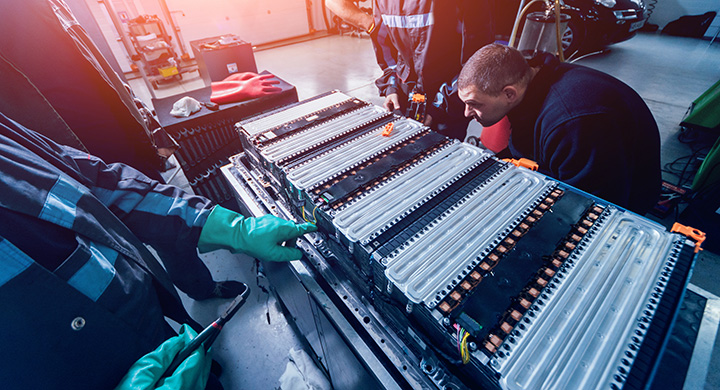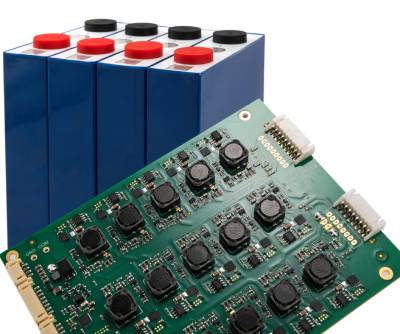
With combustion engines being progressively replaced by electric cars, the development of renewable energy sources and the exponential rise in portable electric systems, our needs for more efficient and reliable energy storage continue to grow. Mobile applications in particular require greater battery life, and current technologies are struggling to respond to these new demands. “Lithium-ion, the leading technology, has reached its physical limitations, especially in terms of energy density, i.e. the amount of energy we can charge per unit of weight or volume,” says Renaud Bouchet, LEPMI researcher and professor at Grenoble INP – Phelma, UGA. “Nowadays, for example, with a 350 kg battery, an electric car can only travel 400 kilometres on average. This number needs to be doubled. But to do so, the technology needs to be changed.”
Towards “solid-state” batteries
Beyond their energy density, one of the weaknesses of lithium-ion batteries is their safety. At present, the ionic conductor between the two electrodes is made up of a liquid organic solvent, which can catch fire when it gets hot. “By replacing the liquid electrolyte with a solid electrolyte, we get a battery that is much more stable, and therefore less dangerous, with a solid state rather than liquid. This also makes it possible to improve its energy density.”
At LEPMI, researchers are working on two kinds of solid electrolytes: polymer- or composite-based electrodes, and oxide or sulfide-based ceramic electrolytes. Shaping the oxides involves a sintering phrase, where the multiple layers are heated to a high temperature (positive/oxide electrolyte/negative) to densify and shape the interfaces, but which generally causes chemical reactions at the interfaces and creates mechanical stress, making the entire thing more fragile. “We are therefore developing a flash 10-second sintering process, which would limit inter-material reactivity at the interfaces.” As for sulfide-based solid electrolytes, while they don’t require high temperatures to be shaped (as they are made from plastic), they must be kept under high pressure during the cycling process to keep the interfaces close together. “Which also raises a number of problems that we are trying to resolve.”
The researchers are adding lithium metal to the negative electrode in these solid electrolytes, which poses a challenge both for them and for scientists all over the world (see article). For the positive electrode, they are trying materials with high potential to increase the accumulator’s electromotive force, such as “nickel rich” lamellar compounds (LiNi0,8,Co0,1Mn0,1O2), LNMO spinels (LiNi0,5Mn1,5O4) and those with high capacity like sulfur. Each material has its own specific difficulties to be overcome.
Sulfur, for example, is an abundant, low-polluting material. “In this case, it’s no longer a question of potential, but the amount of electricity that we can exchange,” says Renaud Bouchet. “In fact, a positive sulfur electrode combined with a negative lithium metal electrode could multiply the capacity for electron exchange by ten.” Cheap, eco-friendly and high-performing, these batteries are of great interest to industry players and slated for electric vehicles and stationary applications (second-life batteries). Unfortunately, when cycling sulfide-based batteries, it goes from a solid, to soluble polysulfides, to a solid final compound, lithium sulfide Li2S. These successive changes in state lead to a ‘redox shuttle’ phenomenon, which produces an ionic short circuit causing poor energy output and premature degradation of the lithium. Researchers are trying to better understand these phenomena so as to prevent them.

Another field of research in the laboratory is ‘redox flow batteries’. This is where the active materials are placed in a reservoir in the form of dissolved ions. The output of these batteries is quite low, but the quantity of energy and power available can be modulated by adjusting the size of the reservoir and the number of modules. They could be useful for stationary applications, the chemical industry and manufacturers that can store large reservoirs.
Alongside new chemical development, LEPMI is working on improving classic lithium-ion batteries by optimising the components, testing positive electrode materials and working on additives for electrolytes in the aim of stabilising interfaces and therefore improving their lifespan.
Of course, all these evolutions must take multiple constraints into account, such as cost, resource availability and safety. The choice of electrolyte and active materials becomes essential, as they have to be cheap, easy to access and highly stable, all at once. For now, the perfect solution doesn’t exist. “No battery meets all these constraints. Everything is a matter of compromise, depending on the application. That is why there needs to be more fundamental research, in connection with applied research.”


